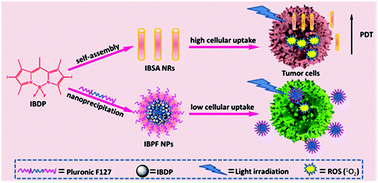Rod-like BODIPY nanomaterials with enhanced photodynamic activity†
Abstract
To develop efficient nanoparticles for photodynamic therapy (PDT), it is highly desirable to systematically construct and evaluate nanoparticles with on-demand biological behavior. It has been well studied that cellular uptake largely depends on the geometric properties of nanoparticles. In this study, we prepared organic nanoparticles with rod-like morphology via small molecule self-assembly, and spherical nanoparticles were used as the control. Then we studied their cellular behavior in detail through their cellular uptake, photodynamic efficacy and ability to kill cancer cells. The results indicate that the nanoparticles with spherical and rod-like morphology were well internalized by cancer cells, and the nanoparticles with rod-like morphology showed better imaging performance and higher in vitro phototoxicity compared to their spherical counterparts. The above results indicate that rod-like nanoparticles possess great potential for cancer treatment in terms of efficient delivery and ideal anti-cancer efficacy. Our studies provide useful and fundamental information for designing efficient therapeutic systems.



 Please wait while we load your content...
Please wait while we load your content...